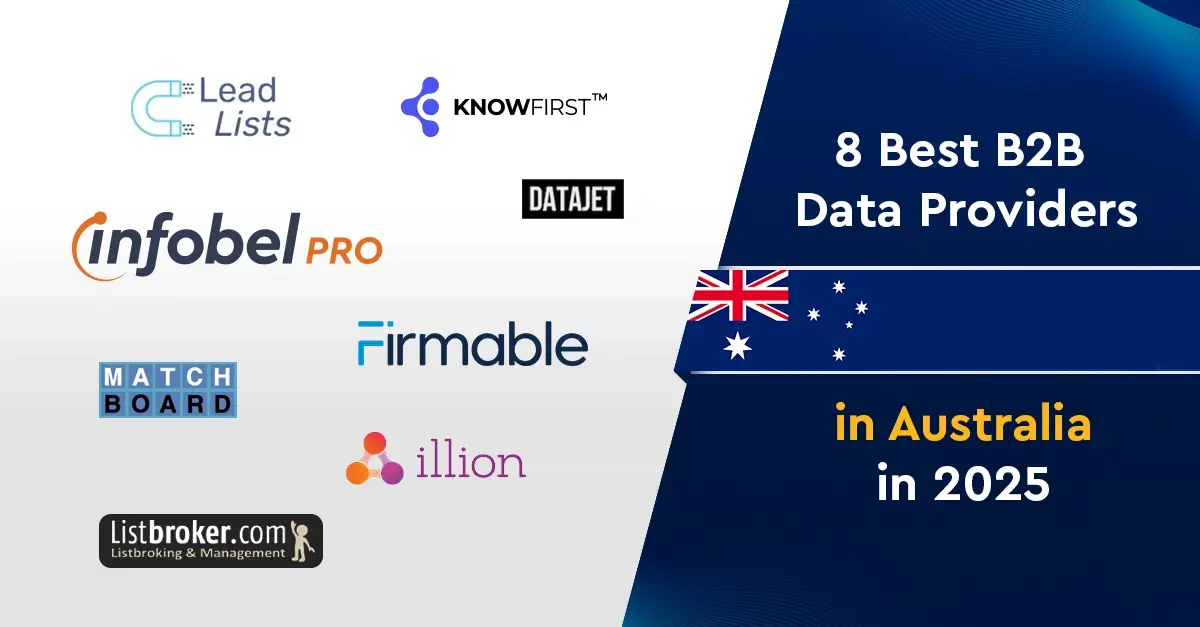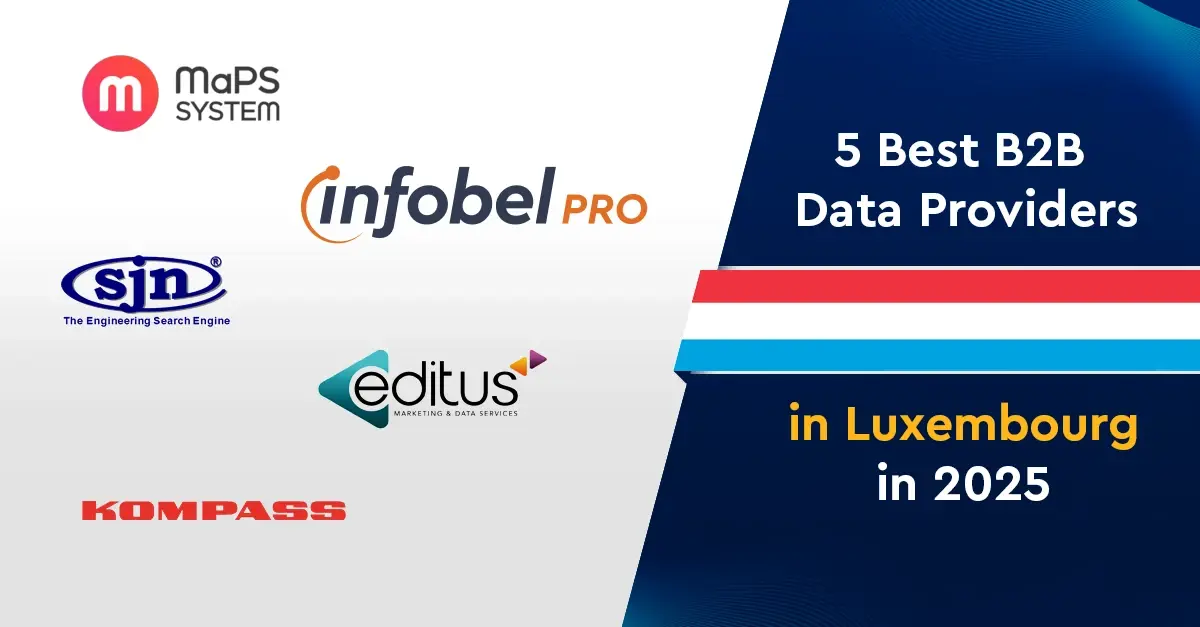Understanding B2B Intent Data Insights
In the vast expanse of the B2B marketing universe, every click defines a digital footprint. Imagine having access to a crystal ball, an orb that reveals the present as well as predicts the most future events. The same happens with B2B marketers, similar to the cosmic voyagers who navigate through the celestial sea of data in search of some elusive constellations of client interests. In this scenario, B2B data acts as a compass that not only sticks north but also unravels the secrets of what lies beyond understanding.
In the ever-changing landscape of B2B marketing, it is vital to understand the intricacies of customer behaviour. One of the most important tools that help in the transformation of marketing paradigms is B2B intent data. It is a potent source of sharing insights and bringing forward the interests and intentions of potential clients.
Let us understand and gain in-depth knowledge of B2B intent data, its significance, different types of intent data, key providers, and actionable insights. As we move forward on this study, we uncover the complexities of intent data while shedding light on how marketers leverage the refinement of their strategies and gain a competitive edge.
.jpg?width=500&height=180&name=Green%20and%20Yellow%20Minimalist%20Business%20Training%20Agency%20Instagram%20Post%20(59).jpg)
What is B2B Intent Data?
B2B intent data can be understood as the kept treasure of information which is fetched from online activities and is reflected in a business's interest or condition to avail of specific products or services. Unlike fetching traditional demographic data, intent data leverages real-time data insights into understanding the behavioural patterns of prospective clients. This information has become significant in curating targeted and personalized marketing and sales campaigns, in resonance with the audience.
.jpg?width=500&height=281&name=Green%20and%20Yellow%20Minimalist%20Business%20Training%20Agency%20Instagram%20Post%20(60).jpg)
Let us understand buyer intent data through some examples illustrated below:
a) Identification of Purchase Intent Through Search Queries:
Consider a technology organization which specializes in solutions related to cybersecurity. Analysis of the search engine queries within their target audience brings an indication towards a heightened interest in cybersecurity and signals potential businesses which actively are looking for solutions. Leveraging this insight allows the organization that tailor marketing and sales efforts, to address specific concerns and requirements reflected through these search queries.
b) Intent Indicated Through the Content Consumption Patterns
Imagine a B2B software provider organization which offers a range of solutions. Foster a detailed observation of the types of intent data or data fetched through the consumption of content specifically related to the content for cloud integration and enhanced scalability. This is how intent data brings forward an intention that businesses are looking for and solutions that can help them with scaling their operations and enhancing their customer base, hence monitizing their commercial intent. Fledged with knowledge, the software provider can create targeted content like case studies and webinars that reflect their products catering to their scalability needs.
c) Monitoring Event Engagement for Targeted Outreach:
A marketing agency holding specialization in B2B services experiences that multiple businesses are consistently attending webinars on the latest trends in digital marketing for their specific genres. This event intent data also reflects a critical interest in promoting their marketing needs and strategies. Composed with knowledge, the agency can easily reach these businesses with curated offerings to the sales team who position themselves as experts in specific niches during the webinars.
d) Social Media Conversations as a Source of Intent:
Imagine a software organization that monitors its social media interactions. They experience a surge in the number of consumers who discuss challenges related to outdated software solutions and seek recommendations for modern alternatives. This social media intent data is an indication towards a potential need for software upgrades. The organization can engage in these conversations share valuable insights and position their products as solutions to the challenges raised.
Types of B2B Intent Data
.jpg?width=500&height=331&name=Green%20and%20Yellow%20Minimalist%20Business%20Training%20Agency%20Instagram%20Post%20(61).jpg)
Below are some of the major categorizations of the B2B Intent Data:
- Content Consumption Intent Data:
Analysis of the content type that a user prefers to engage with provides a peek into the insights offered towards their informational and commercial intent. These are mainly whitepapers, blog posts, or case studies that reflect a deeper interest in respective topics.
- Social Media Intent Data:
Keeping track of various social media platforms, interactions and discussions reveals much-needed sentiments and preferences within the business community while offering a nuanced approach and understanding towards industrial trends.
The Significance of B2B Intent Data
- Precision in Targeting
B2B intent data helps empower marketers in identifying businesses that are actively in search of products or services in their industry. This precision helps ensure that all the marketing efforts are in alignment and directed towards the audience most likely to convert. This helps in optimizing resources and maximizing return on investment in maximum ways.
- Improvised Personalization
Getting an adept understanding of user behaviour and the intent behind online activities helps marketers and the organization's own sales and marketing team to define and create highly personalized and relevant content. Curating messages that match the intent of the audience helps enhance engagement, build stronger connections, and improve brand loyalty.
- Effective Resource Allocation for Marketing and Sales Teams
Insights into buyer intent data facilitate efficient resource allocation. A focused approach on different target accounts actively looking for solutions helps marketers to optimize both budget and time constraints which also ensures the levying of a strategic approach to resource management.
Understanding Intent: A Pillar of Effective Marketing For Sales and Marketing Teams
To understand within the context of online behaviour, Intent acts as the linchpin for implementing effective marketing strategies. It comprises the purpose or goals behind the online actions of the users thereby providing a roadmap for sales teams that help them in curating their efforts based on the user's preferences in the buyer journey. Recognition and categorization of these intents form the base of forming adept marketing strategies.
Let us delve into the four major categories of the user's intent:
Informational Intent:
Users reveal this intent while looking for the most relevant answers to their specific raised questions; portraying a thirst for adequate knowledge and understanding.
Navigational Intent:
This takes place when users are aimed at finding any up-to-date particular page, website, or physical location which indicates a focused and purposeful search criteria.
Commercial Intent:
In this users leveraged in the commercial phase are in the stage of exploration and research for brands or services before embarking on a decision and represent a vital opportunity for marketers.
Transactional Intent:
In this stage, users are usually ready to take specific actions while signifying their intent to complete a specific action or conversion.
A precise understanding of these intent categories helps in laying the groundwork and deciphers user behaviour, tailoring personalized marketing campaigns and efforts that align with the needs of the users at different stages and pain points of their purchasing journey.
What is Intent in Data Science?
Intent, in data science, refers to the underlying purpose or goal behind the online actions or interactions of users with data. It includes deciphering the motives that lead to user behaviour and providing valuable insights into their process of decision-making. It is important to understand the intent of data scientists as it helps them predict and interpret user actions, curate recommendations, and optimise algorithms for better user needs.
There are various types of Intent in data science based on the context and the nature of data analysis. For example:
Search Intent Data
This data reveals the purpose of the users while searching for data. Their search could be in terms of seeking knowledge, i.e. informational, or looking for a specific page or resource, i.e. navigational, or researching on products or services, i.e. commercial, or intent to make a purchase or perform an action, i.e. transactional.
Purchase Intent Data:
This indicates the likelihood of a user making a purchase based on their behaviour like browsing specific pages for products, adding items to a shopping cart, or engaging with the website forms pricing information.
Content Consumption Intent:
This is related to the interest of users in using specific keywords and the consumption of specific types of content like articles, videos, or social media posts. Analysis of content consumption intent supports curating content recommendations.
User Engagement Intent:
This includes analysis and understanding of the intent of the user for the engagement with a platform, application, or service. This is measured through metrics like click-through rates, time spent on a page, or interactions with features.
Data scientists employ different techniques which include machine learning algorithms, natural language processing, and statistical analysis for discerning intent patterns from vast datasets. Disclosing these layers of intent within the data, data scientists improve user experiences, enhance personalization and account intelligence, and contribute to the overall success of data-driven applications and systems.
What is Intent Data in Lead Generation?
Intent data in lead generation implies the information gathered from online activities that further devises the interest or intent of the potential customer to make a purchase. It is an important resource for B2B marketers which helps them to identify businesses or individuals that actively research or consider specific products or services. Intent data helps in gaining insights into the digital behaviours of prospects, which allows marketers to curate their outreach efforts and foster engagement with leads who are more prominent to convert.
Key aspects of intent data in lead generation:
- Behavioural Signals:
Intent data is fetched from the online actions of potential customers like web searches, content consumption, and engagement with specific industrial events or forums. Analysis of these signals helps marketers understand the level of interest and the specific topics or solutions prospects are willing to explore. - Identification of Active Buyers:
Monitoring of buyer intent signals helps marketers distinguish between leads who are just browsing and those actively researching to make a purchase. The difference leads to more targeted and effective lead-generation efforts. - Content Preferences:
Intent data reveals the type of content prospects that you are engaging with. Whether it is whitepapers or case studies which are considered after understanding the content preferences that enable marketing teams to tailor content strategies in alignment with the needs and interests of prospective clients. - Timing and Relevance:
Intent data helps in fetching insights for the apt timing of a prospect's interest. Understanding when a lead is looking for information or solutions allows marketers to deliver relevant communications promptly with an increased likelihood of successful lead conversion. - Improved Personalization:
Fledged with intent data, marketers can personalize their strategies. Ranging from curated email campaigns to targeted advertisements, personalization based on inferred intent drastically improves the effectiveness of lead-generation efforts.
Where Can I Find Intent Data?
.jpg?width=500&height=333&name=Green%20and%20Yellow%20Minimalist%20Business%20Training%20Agency%20Instagram%20Post%20(66).jpg)
The best way to identify patterns and gather intent data is to understand where it can be found:
CRM
Your CRM should be the known first-party intent data.
Google Analytics
This is the best way to fetch anonymous first-party intent data.
B2B Intent Data Providers:
Providers like Bombara, Demandbase, and Cognism are well-known platforms for providing adept intent data along with both first-party and third-party data based on preferences.
Intent Data Providers
Choosing the right intent data provider is as important as incorporating intent data. This is done to obtain specifically precise and actionable insights. Multiple providers provide first-party data, and third-party data and specialise in the collection and analysis of intent data with unique intent data tools, features, and capabilities. Let us uncover some of the key players where you can purchase intent data wherein, Cognism, Demandbase and Bombara lead the list.
Bombara:
Well known for its advanced algorithms, Bombara helps in fetching predictive intent data which helps in the identification of businesses most likely to convert in the future.
Choosing a data provider in alignment with our specific business needs and goals is important for unlocking the full potential of B2B intent data.
Cognism:
With its defined speciality in the devised consumption of intent data, Cognism helps in delivering insights into the type of content clients lay their hands on and provides comprehensive B2B intent data solutions to its clients.
Demandbase:
Known for its extensive database and monitoring capabilities valid in real-time, Demandbase stands out as a devised provider of B2B intent data solutions.
Leveraging Intent Data in B2B Marketing Strategies & Sales Team:
It is important to understand how to leverage intent data or implement the use of B2B intent data effectively. This helps in the further transformation of insights into actionable strategies; which further roll out as key strategies that strengthen the marketers to harness the full potential of intent data and derive actionable insights for successful campaigns.
- Enhanced Segmentation & Targeting
Intent data empowers marketers to prevail beyond just the traditional demographic-based segmentation and expand into gaining behavioural insights. Segmentation of audience is based on the pertained level of interest and intent where marketing and sales teams of specific organizations can create highly targeted campaigns curated to the specific needs and preferences of each segment.
Example:
Imagine a software organization with a pool of products that cater to various business needs. By utilizing intent data, they help in the identification of a segment of businesses that actively search for solutions catering to project management. Curating marketing messages and specified outreach specifically for this segment is an assurance that the organizational communication is in resonance with the unique challenges and requisites of those looking for project management tools. - Personalized Content and Experiences
B2B buyers are fed with information daily. Content personalization which is based on intent data helps marketers to move through the noise that delivers messages and acts in resonance with the identification of intent of potential clients. Whether we address informational, commercial, or transactional intent, delivery of the right content at the right time is important.
Example:
For a cybersecurity firm, recognition of businesses that exhibit transactional intent also foreruns an opportunity to leverage detailed case studies that showcase successful implementations of their solutions. This targeted content is in direct alignment with the immediate needs of businesses which are ready to take action while promoting trust and enhancing the likelihood of conversion. - Nurture Marketing Campaigns: Guide Through the Buying Journey
Intent data acts as a roadmap for major marketing campaigns and helps in effective sales strategies. Understanding your target market and where a business stands in the buying process and its decision-making enables marketers to share relevant content and communication at each stage with the potential customers of the funnel. This ensures a seamless way for potential clients and helps build trust in moving them towards conversion.
Example:
The automation of marketing helps in the identification of businesses which exhibit commercial intent with the engagement in comparison of guides concerning the marketing tools. Implementation of nurturing campaigns, the platforms help in leveraging targeted emails which provide deeper insights into their product's unique features, an added advantage for the marketing and sales teams keeping an over competitors which guides potential clients towards a well-informed purchasing decision. - Dynamic Retargeting: Staying on the top of mind.
Dynamic retargeting ads help in capitalizing the real-time intent signals. These targeted ads just dynamically adjust the content based on the specific intent signals detected while reinforcing brand awareness and reminding me of potential clients that value proposition. It is about staying top of mind as businesses work forward in their journey of decision-making.
Example:
A software organization notices that businesses explore scalability solutions that reflect an interest in specific features through the interactions on the website interactions. Ads for dynamic retargeting bring forward tailored messages that emphasize these features, implementing the benefits and reminding potential clients of all the available tailored solutions. - Integration with CRM Systems Through A Unified Approach
Integration of B2B intent data with CRM systems is a unified approach that engages potential customers. This integration helps in the facilitation of seamless communication and coordination between both sales and marketing teams which creates a holistic view of the customer journey.
Example:
A CRM system which is integrated with intent data reveals that a business that expresses informational intent has engaged in multiple webinars. This insight helps the marketing and sales teams to reach out with any additional resources which are in alignment with their communication with the demonstrated interest of the target accounts ensuring a coordinated and personalized approach. - Predictive Analytics: Anticipation of the Future Intent
Predictive analytics take B2B intent data to the next level. Implementation of advanced algorithms, marketers can easily identify businesses that are likely to convert in the future. This proactive approach helps in laying strategic planning and adept resource allocation which ensures a competitive edge in the rapidly evolving market.
Example:
A marketing analytics organization that utilizes predictive intent data identifies businesses showcasing early signs of transactional intent. Fledged with this foresight, they deploy pre-emptive marketing strategies like targeted promotions or exclusive offers that capitalize on the potential conversion before competitors are included in the scene.
Utilizing the B2B intent data by the various sales leaders and marketing teams in unique strategic ways transforms it from just information sets to a dynamic force that drives marketing success. A combination of these insights garnered from sets of intent data with strategies tailored to be thoughtful and curated by businesses, fosters business growth helps in meeting the immediate needs of potential clients and builds lasting relationships.





Comments